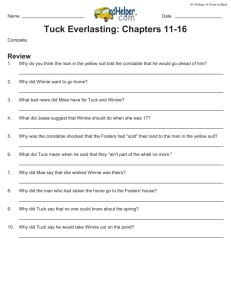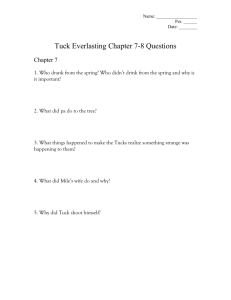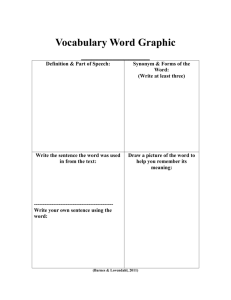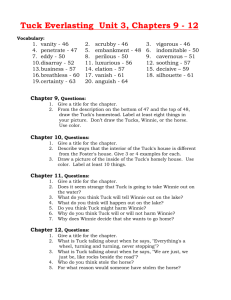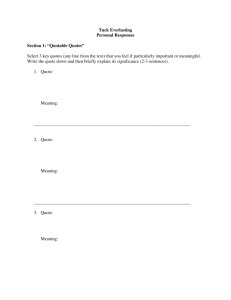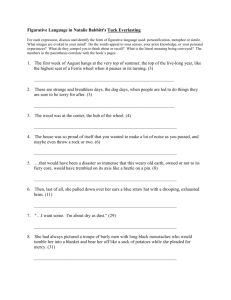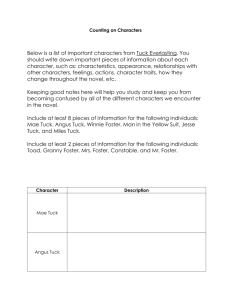Tuck Everlasting
advertisement
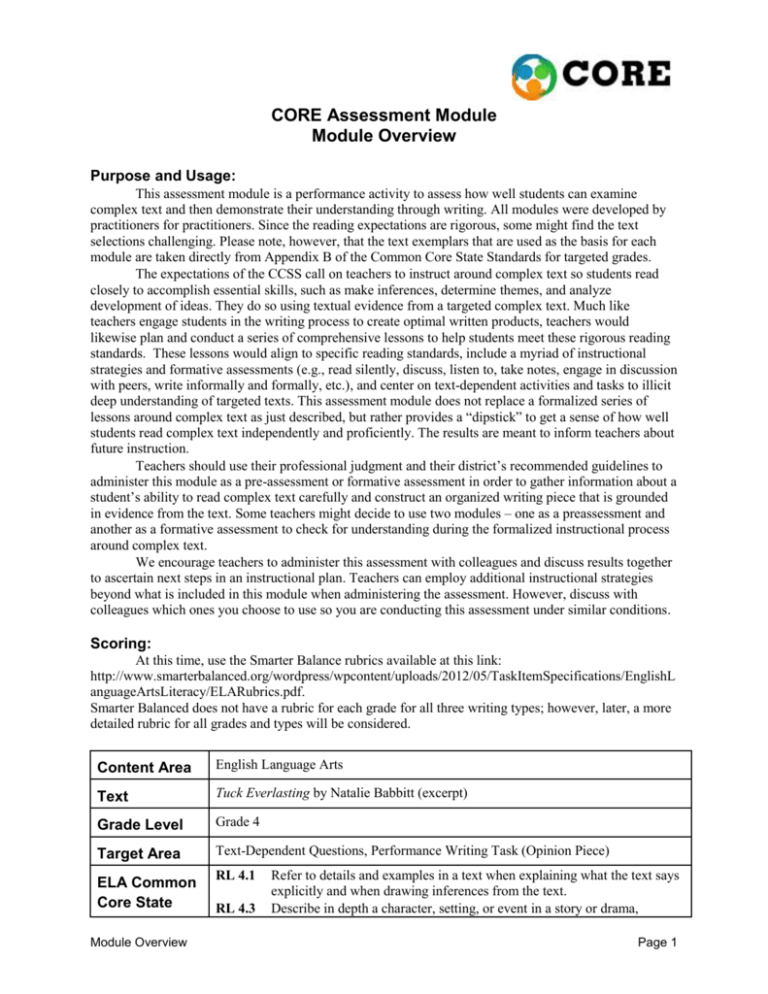
CORE Assessment Module Module Overview Purpose and Usage: This assessment module is a performance activity to assess how well students can examine complex text and then demonstrate their understanding through writing. All modules were developed by practitioners for practitioners. Since the reading expectations are rigorous, some might find the text selections challenging. Please note, however, that the text exemplars that are used as the basis for each module are taken directly from Appendix B of the Common Core State Standards for targeted grades. The expectations of the CCSS call on teachers to instruct around complex text so students read closely to accomplish essential skills, such as make inferences, determine themes, and analyze development of ideas. They do so using textual evidence from a targeted complex text. Much like teachers engage students in the writing process to create optimal written products, teachers would likewise plan and conduct a series of comprehensive lessons to help students meet these rigorous reading standards. These lessons would align to specific reading standards, include a myriad of instructional strategies and formative assessments (e.g., read silently, discuss, listen to, take notes, engage in discussion with peers, write informally and formally, etc.), and center on text-dependent activities and tasks to illicit deep understanding of targeted texts. This assessment module does not replace a formalized series of lessons around complex text as just described, but rather provides a “dipstick” to get a sense of how well students read complex text independently and proficiently. The results are meant to inform teachers about future instruction. Teachers should use their professional judgment and their district’s recommended guidelines to administer this module as a pre-assessment or formative assessment in order to gather information about a student’s ability to read complex text carefully and construct an organized writing piece that is grounded in evidence from the text. Some teachers might decide to use two modules – one as a preassessment and another as a formative assessment to check for understanding during the formalized instructional process around complex text. We encourage teachers to administer this assessment with colleagues and discuss results together to ascertain next steps in an instructional plan. Teachers can employ additional instructional strategies beyond what is included in this module when administering the assessment. However, discuss with colleagues which ones you choose to use so you are conducting this assessment under similar conditions. Scoring: At this time, use the Smarter Balance rubrics available at this link: http://www.smarterbalanced.org/wordpress/wpcontent/uploads/2012/05/TaskItemSpecifications/EnglishL anguageArtsLiteracy/ELARubrics.pdf. Smarter Balanced does not have a rubric for each grade for all three writing types; however, later, a more detailed rubric for all grades and types will be considered. Content Area English Language Arts Text Tuck Everlasting by Natalie Babbitt (excerpt) Grade Level Grade 4 Target Area Text-Dependent Questions, Performance Writing Task (Opinion Piece) ELA Common Core State Module Overview RL 4.1 RL 4.3 Refer to details and examples in a text when explaining what the text says explicitly and when drawing inferences from the text. Describe in depth a character, setting, or event in a story or drama, Page 1 Standards SBAC Assessment Claims Task Overview Module Components drawing on specific details in the text (e.g., a character’s thoughts, words or actions.) RL 4.4 Determine the meaning of words and phrases as they are used in a text, including those that allude to significant characters found in mythology (e.g., Herculean). W 4.1 Write opinion pieces on topics or texts, supporting a point of view with reasons and information. Introduce a topic or text clearly, state an opinion, and create an organizational structure in which related ideas are grouped to support the writer’s purpose. Provide reasons that are supported by facts and details. Link opinion and reasons using words and phrases (e.g., for instance, in order to, in addition). Provide a concluding statement or section related to the opinion presented. *SL 4.1 Engage effectively in a range of collaborative discussions (one-on-one, in groups, and teacher-led) with diverse partners on grade 4 topics and texts, building on others’ ideas and expressing their own clearly. L 4.5a Explain the meaning of simple similes and metaphors in context. Claim 1: Students can read closely and analytically to comprehend a range of increasingly complex literary and informational texts. Claim 2: Students can produce effective and well-grounded writing for a range of purposes and audiences. This assessment task will be completed in two parts. The prewriting/planning in part one involves reading, plus note-taking and speaking and listening in response to text-dependent questions. In part two, students are asked to write an opinion piece. 1) Directions to Teacher 2) Tuck Everlasting Text Passage 3) Active Reading Notes 4) Text-Dependent Questions and Peer Discussion 5) Independent Writing Task *Standard addressed but not explicitly assessed. Module Overview Page 2 Tuck Everlasting by Natalie Babbitt (excerpt) Directions to Teacher This Common Core-aligned ELA Performance Task can be given over two to three days depending on class schedules. The directions below outline the steps to follow for a two-day administration. Text: Babbitt, Natalie. Tuck Everlasting. New York: Farrar, Straus and Giroux, 1975. (1975) From Chapter 12 Materials: Tuck Everlasting Text Passage Tuck Everlasting Active Reading Notes Text-Dependent Questions Graphic Organizer Writing Task Lined paper for writing DAY 2 1. Reading (Approximately 15 minutes) Give students the Tuck Everlasting Text Passage and instruct them to read it silently. 2. Active Reading (Approximately 15–20 minutes) Distribute the Tuck Everlasting Active Reading Notes and ask students to reread the passage and complete the 2-column graphic organizer. 3. Note-taking Around Text-Dependent Questions (Approximately 30 minutes) Distribute the Text-Dependent Questions Graphic Organizer sheet. Instruct students to complete the “My Responses” and “Evidence From the Text” sections only that are predicated on text-dependent questions. Encourage students to expand their thinking beyond literal responses. Figurative Language (L.4.5a) – In the first paragraph, the author uses the phrase, “like color spilled from a paintbox.” What is the meaning of this phrase as used in the passage? Key Details/Inference (RL.4.1, RL.4.3) – What personality trait would you use to describe Winnie? What evidence from the text supports this trait? Central Ideas (RL.4.1) – Reread the last paragraph. How does Tuck feel about life? Use evidence from the passage to support your answer. ELA Performance Task Grade 4 3 Reasoning/Evaluation and Figurative Language (RL.4.3, L.4.5) – Describe the setting. What role does the setting play in the story? How does it connect to Tuck’s feelings about life? 4. Speaking/Listening Exercise (Approximately 15 minutes) In pairs or groups of three, give students time to discuss their responses to their active reading notes and text-dependent questions. Remind and encourage them to include textual evidence during their discussions. After a designated period of time, instruct students to independently complete the “My Thoughts Now” section of the TextDependent Questions Graphic Organizer based on their peer conversations. Tell them they will respond to a writing prompt and can use both their notes and the graphic organizer while writing. DAY 2 Performance Task (Writing Prompt) (Approximately 30 minutes) Distribute the writing prompt and let students know the amount of time they have to respond to it. Encourage students to use their notes while reading and their graphic organizers to inform their writing. ELA Performance Task Grade 4 4 Tuck Everlasting Text Passage By Natalie Babbitt The sky was a ragged blaze of red and pink and orange, and its double trembled on the surface of the pond like color spilled from a paintbox. The sun was dropping fast now, a soft red sliding egg yolk, and already to the east there was a darkening to purple. Winnie, newly brave with her thoughts of being rescued, climbed boldly into the rowboat. The hard heels of her buttoned boots made a hollow banging sound against its wet boards, loud in the warm and breathless quiet. Across the pond a bullfrog spoke a deep note of warning. Tuck climbed in, too, pushing off, and, settling the oars into their locks, dipped them into the silty bottom in one strong pull. The rowboat slipped from the bank then, silently, and glided out, tall water grasses whispering away from its sides, releasing it. Here and there the still surface of the water dimpled, and bright rings spread noiselessly and vanished. “Feeding time,” said Tuck softly. And Winnie, looking down, saw hosts of tiny insects skittering and skating on the surface. “Best time of all for fishing,” he said, “when they come up to feed.” He dragged on the oars. The rowboat slowed and began to drift gently toward the farthest end of the pond. It was so quiet that Winnie almost jumped when the bullfrog spoke again. And then, from the tall pines and birches that ringed the pond, a wood thrush caroled. The silver notes were pure and clear and lovely. “Know what that is, all around us, Winnie?” said Tuck, his voice low. “Life. Moving, growing, changing, never the same two minutes together. This water, you look out at it every morning, and it looks the same, but it ain’t. All night long it’s been moving, coming in through the stream back there to the west, slipping out through the stream down east here, always quiet, always new, moving on. You can’t hardly see the current, can you? And sometimes the wind makes it look like it’s going the other way. But it’s always there, the water’s always moving on, and someday, after a long while, it comes to the ocean.” Source: Babbitt, Natalie. Tuck Everlasting. New York: Farrar, Straus and Giroux (1975). Chapter 12 excerpt ELA Grade 4: Tuck Everlasting Page 1 Student Name ______________________ Tuck Everlasting Active Reading Notes Directions: The author Natalie Babbitt uses descriptive language to help portray the setting throughout the passage. Underline examples of descriptive language from the text in the left hand column. In the right column, explain how the author uses it to present a picture in the reader’s mind. TEXT PASSAGE Underline or highlight examples of descriptive language. The sky was a ragged blaze of red and AUTHOR’S PURPOSE What picture is the author presenting? EXAMPLE: The author wants the reader to picture pink and orange, and its double trembled on the the sun setting and the sky filled with vibrant, vivid surface of the pond like color spilled from a color. paintbox. The sun was dropping fast now, a soft red sliding egg yolk, and already to the east there was a darkening to purple. Winnie, newly brave with her thoughts of being rescued, climbed boldly into the rowboat. The hard heels of her buttoned boots made a hollow banging sound against its wet boards, loud in the warm and breathless quiet. Across the pond a bullfrog spoke a deep note of warning. Tuck climbed in, too, pushing off, and, settling the oars into their locks, dipped them into the silty bottom in one strong pull. The rowboat slipped from the bank then, silently, and glided out, tall water grasses whispering away from its sides, releasing it. Here and there the still surface of the water dimpled, and bright rings spread noiselessly and vanished. “Feeding time,” said Tuck softly. And Winnie, looking down, saw hosts of tiny insects skittering and skating on the surface. “Best time of all for fishing,” he said, “when they come up to feed.” ELA Grade 4: Tuck Everlasting Page 2 Student Name ______________________ TEXT PASSAGE Underline or highlight examples of descriptive language. AUTHOR’S PURPOSE What picture is the author presenting? He dragged on the oars. The rowboat slowed and began to drift gently toward the farthest end of the pond. It was so quiet that Winnie almost jumped when the bullfrog spoke again. And then, from the tall pines and birches that ringed the pond, a wood thrush caroled. The silver notes were pure and clear and lovely. “Know what that is, all around us, Winnie?” said Tuck, his voice low. “Life. Moving, growing, changing, never the same two minutes together. This water, you look out at it every morning, and it looks the same, but it ain’t. All night long it’s been moving, coming in through the stream back there to the west, slipping out through the stream down east here, always quiet, always new, moving on. You can’t hardly see the current, can you? And sometimes the wind makes it look like it’s going the other way. But it’s always there, the water’s always moving on, and someday, after a long while, it comes to the ocean.” Source: Babbitt, Natalie. Tuck Everlasting. New York: Farrar, Straus and Giroux (1975). Chapter 12 excerpt ELA Grade 4: Tuck Everlasting Page 3 Student Name ______________________ Text-Dependent Questions Graphic Organizer Directions: After rereading the text, write answers to each question below in the “My Response” section. Support each response by recording textual evidence in the “Evidence from the Text” section. After you are given time to talk to a classmate and share ideas, complete the “My Thoughts Now” section based on your conversation. 1. In the first paragraph, the author uses the phrase, “like color spilled from a paintbox.” What is the meaning of this phrase as used in the passage? My Response Evidence From the Text My Thoughts Now 2. What personality trait would you use to describe Winnie? What evidence from the text supports this trait? My Response Evidence From the Text My Thoughts Now ELA Grade 4: Tuck Everlasting Page 4 Student Name ______________________ 3. Reread the last paragraph. How does Tuck feel about life? Use evidence from the passage to support your answer. My Response Evidence From the Text My Thoughts Now 4. Describe the setting. What role does the setting play in the story? How does it connect to Tuck’s feelings about life? My Response Evidence From the Text My Thoughts Now ELA Grade 4: Tuck Everlasting Page 5 Student Name ______________________ Tuck Everlasting Writing Task Directions: Please respond to the prompt below in writing. You may use your notes and graphic organizer to inform your writing. Writing Prompt After reading Natalie Babbitt’s excerpt from Tuck Everlasting, write an opinion piece about whether the author’s description of the setting helps to reveal how Tuck feels about life. Remember to: Make a statement about how Tuck feels about life. Give an opinion whether the author’s description of the setting helps to reveal how Tuck feels about life. Include reasons for your opinion and support them with detailed evidence from the text. Be Sure To: Introduce your topic clearly and group related information into paragraphs. Provide reasons for your opinion that are supported by facts and details from the text. Use words and phrases to link your opinion with your reasons (e.g., another, for example, for instance, also, in addition). Provide a concluding statement or section related to the opinion presented. Check for proper grammar and writing conventions. ELA Grade 4: Tuck Everlasting Page 6
